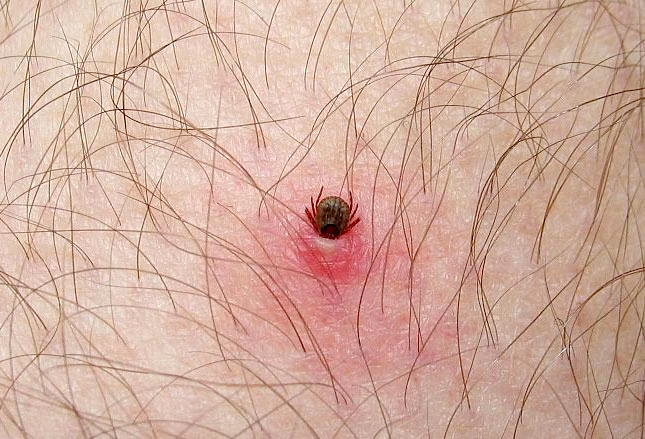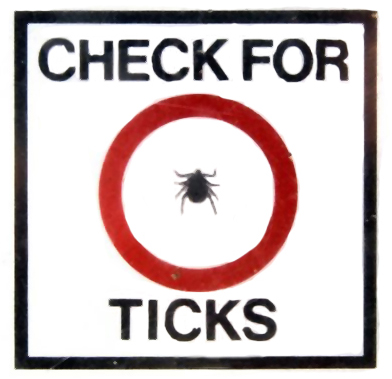What’s Eating You? Ticks and Fleas
Ok, ok, ok! I’ve been informed more than once this week that two other bugs have an affinity for human flesh and are seen just as often, at least in the warmer climes. I admit I had forgotten about the more, let’s say: “winter challenged” (equatorially inclined) portions and desert areas of this great world where both ticks and fleas flourish.
Not all areas infested with ticks have warning signs
Seeing less injuries and poison ivy now makes it all to apparent to us medical types that we hadn’t killed them all off, we just were “distracted” a bit from noticing them. So, here’s the latest information on these two problems causing itching rashes in children too: ticks and fleas.
Less Rash, More Deadly, Still Itches
Besides the obvious fact that both ticks and fleas also attack household pets, these two are: a little less prone to cause a rash themselves, still itch and a whole lot more prone to carry other diseases—which are deadly.
Ticks
In adult form these parasites are large enough to be seen without magnification and eagerly feed on humans, pets, livestock and wildlife. More common in warm, humid regions, all of them feed on blood but a few of them attack humans.

They feed by using a salivary cement to attach themselves then a tubular mouth with blades to bore a hole into their host. They are tough to kill because of their anatomy, hard plates on top and bottom with flexible membrane in between. That’s how they blow up when engorging on vast amounts of blood. A barely visible “seed tick” can ten-tuple their size after feeding.
You’ve been told that ticks can be deadly, and it’s true. The reason is that ticks are easily infected by other bacteria: Rocky Mountain spotted fever, Lyme disease, tularemia, ehrlichiosis, babesiosis, Colorado tick fever, and relapsing fever to name but a few of those seen in the US.
A rash accompanied by fever or flulike symptoms may indicate a tick-borne disease, especially if the person has any reason to think they’ve been in contact with a tick. The rash in most normal viruses comes when the fever breaks. These rashes are accompanied by fever. Lyme disease many times has a very distinctive circular or even bulls-eye rash which, when seen, nearly clinches the diagnosis; but, it’s not always seen.

The angry, red papules of Rocky Mountain Spotted Fever are less diagnostic but the person is usually really sick to the point of hospitalization.
A high index of suspicion with careful inspection and removal is the best treatment. Parents should insist on children taking a warm bath after spending time in areas known to contain a tick population and help them inspect areas they can’t readily see. If one is spotted remove it carefully with tweezers.
Clean the tweezers, grasp the tick as close to the surface of the skin as possible but be sure not to squeeze the tick’s body. Employ steady, even pressure, pulling upward until the cement cone attaching the tick to its host breaks and the tick is dislodged. Twisting or jerking the tick can cause the mouth to break off and remain in the skin.
If the tick breaks, remove the mouth with the tweezers; however, if the mouth cannot be easily tweezed out, leave it in place and allow the skin to heal. Following tick removal, flood the area with alcohol followed by soap and water to clean the area. Contact your doctor at the first sign of fever, rash or feeling ill and be sure to tell him about the tick because these are not diseases usually seen and easy to forget to consider.
Fleas

Fleas have contributed more to the total of human misery throughout history than any living thing— except perhaps kings and tyrants. Their deadliness cannot be overstated because they transmit a wide list of pathogens and their diseases. To give but a few in order to orient you to the problem: bubonic plague, murine typhus, cat scratch fever, tungiasis, and tapeworms.
They are wingless parasites evolved to inflict nearly every animal known to man. In North America, three species of flea commonly attack people: Pulex irritans (the human flea), Ctenocephalides felis (the cat flea), and C canis (the dog flea). The human flea actually feeds on a wide variety of mammals, and the cat and dog fleas readily trade hosts.
The larvae of fleas are vermiform (worm-like), eyeless, and limbless and they actually burrow deep into carpets and furniture in order to feed on decaying organic matter as they mature.

Adult fleas are equipped with sharp, hooklike claws on their feet and piercing-sucking mouthparts. Their hind legs contain compressible elastomeric protein that, when released, catapults their tiny mass up to 150 times its own body length—the equivalent of a human jumping further than a football field. The photo above shows Xenopsylla cheopis (Oriental rat flea), the primary vector for plague, engorged with blood.
On a child, parents usually see a punctate, hemorrhagic area where the insect has probed to find an acceptable feeding site. A wheal then usually develops around the bite, accompanied by pruritus. After 12-24 hours, a hardened, papillar lesion appears.
Secondary infection brought on by scratching is a possible further complication. The symptoms of the bites themselves are minor and can be relieved with over-the-counter salves and lotions. Fleas inhabit the nesting sites of wild and feral animal populations and often come into the home on domestic pets. Many insecticidal remedies are available.
7 Posts in Bug Bites (bugbites) Series
- Part 2 - 33 things about bug bites: fleas, bed bugs, spiders, Zika, Dengue and Ehrlichiosis. – 28 Mar 2018
- Part 1 - 33 things about bug bites: Ants, Chiggers, Ticks – 23 Mar 2018
- Ticks and Fleas – 11 Dec 2016
- Bed bugs, Mites and Lice – 7 Dec 2016
- Mosquitos and their illnesses – 23 Jun 2016
- Scabies is coming back! – 27 Oct 2014
- Bug Bites Series: Intro/Index – 15 Oct 2014

